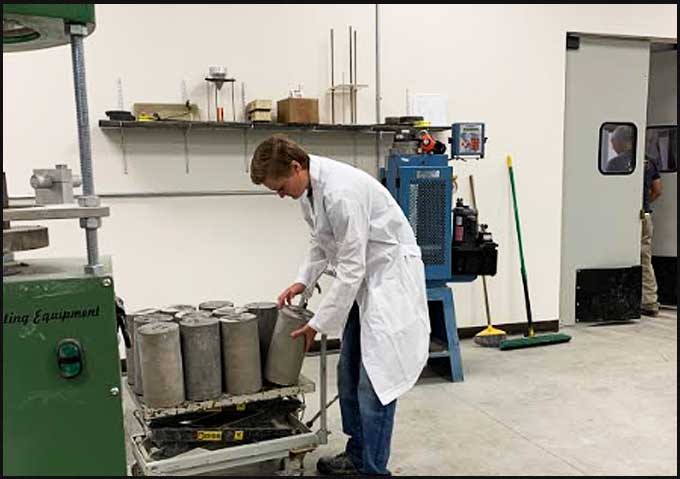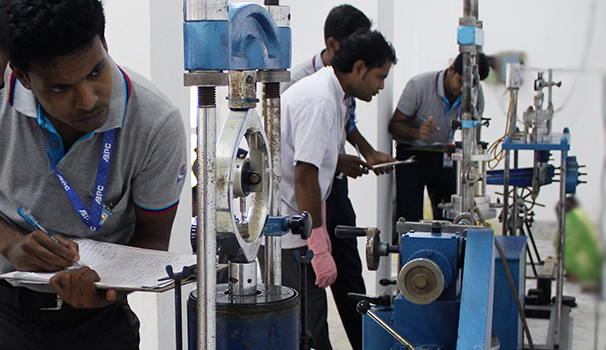Your Trustworthy Material Testing Lab Partner: A Commitment to Excellence
Your Trustworthy Material Testing Lab Partner: A Commitment to Excellence
Blog Article
Innovations in Product Screening for Improved High Quality Assurance
From non-destructive screening strategies to automated systems, the area of material testing has actually seen remarkable developments. In this conversation, we will certainly explore some of the most current trends in material screening, consisting of the use of innovative sensor modern technologies, the combination of data analytics, and the function of artificial knowledge. Allow's dive right into the world of advancements in product testing and find just how these innovations are shaping the future of high quality guarantee.
Non-Destructive Evaluating Techniques
Non-Destructive Screening Approaches play a critical role in making certain the integrity and quality of materials without compromising their structural stability. These techniques are utilized in different sectors, consisting of aerospace, production, and building and construction, to find and recognize issues or abnormalities in materials or structures. By making use of non-destructive screening service technicians, engineers and techniques can assess the buildings, qualities, and performance of products without causing any type of damage.
One generally utilized non-destructive testing technique is ultrasonic testing (UT) UT includes making use of high-frequency audio waves to spot imperfections such as fractures, gaps, and additions in products. This method functions by transmitting ultrasonic waves into the product and evaluating the mirrored waves to determine the visibility and location of any type of problems. UT is especially reliable for inspecting welds, pipes, and various other structures constructed from metal or composite materials.

Non-destructive testing techniques supply beneficial details about the quality and reliability of materials, guaranteeing that they satisfy the needed criteria and requirements. By applying these strategies, sectors can boost their quality control procedures, lessen the danger of failing or mishaps, and eventually deliver safer and more dependable products to customers.

Automated Screening Systems
Automated testing systems have actually transformed the area of material testing, offering precise and efficient approaches for reviewing the top quality and honesty of products. These systems use advanced innovations and algorithms to automate the screening procedure, minimizing human error and enhancing productivity.
One trick benefit of automated testing systems is their ability to execute examinations at a much faster rate than manual screening techniques. With making use of robotics and sophisticated software program, these systems can carry out several tests all at once, dramatically lowering the time needed for testing large sets of materials.
In addition, automated screening systems provide a greater level of precision and precision compared to hand-operated testing. They can execute tests with regular specifications, guaranteeing that the outcomes acquired are dependable and reproducible. By getting rid of human subjectivity and variability, these systems give a much more unbiased evaluation of material high quality.
Furthermore, these systems are furnished with advanced sensing units and detectors that can discover also the smallest issues or discrepancies in product properties. This allows very early detection of possible concerns, permitting suppliers to take restorative activities prior to the products are made use of in essential applications.
In addition to their effectiveness and precision, automated screening systems also enhance safety and security in material testing. By lessening human participation in possibly unsafe testing procedures, these systems minimize the threat of crashes and injuries, making sure a more secure working setting.
Advanced Sensor Technologies
With the integration of advanced sensor innovations, product screening systems have actually attained also better levels of precision and efficiency (material testing lab). Advanced sensor modern technologies play an essential role in improving the high quality guarantee procedure by giving accurate and real-time information throughout material testing. These sensing units are capable of identifying and measuring numerous physical buildings such as temperature level, pressure, vibration, and strain, permitting for a thorough evaluation of the product's behavior under various problems
Among the crucial improvements in sensing unit innovations is the advancement of wireless sensing units. These sensing units get rid of the requirement for troublesome electrical wiring and enable seamless information transfer, improving the overall flexibility and flexibility of the screening procedure. Furthermore, cordless sensors can be easily integrated right into existing material testing systems, making them a cost-effective solution for boosting and upgrading screening capacities.

Artificial Intelligence in Material Testing
Synthetic knowledge has transformed the field of material screening, bringing unprecedented levels of accuracy, effectiveness, and anticipating abilities to the quality control procedure. With the capability to assess large quantities of information and recognize patterns that might go undetected by human operators, AI algorithms have significantly improved the reliability of material screening treatments.
Among the vital benefits of making use of AI in material screening is its capability to forecast material behavior under various conditions. By training AI designs on historic data, researchers can create predictive designs that can estimate the efficiency of products in real-world situations. This permits suppliers to enhance material selection and layout, decreasing the need for lengthy and costly experimental procedures.
Additionally, AI can streamline the product and automate testing procedure, enhancing performance and minimizing human mistake (material testing lab). AI-powered company website systems can autonomously perform screening treatments, collect and assess information, and generate extensive records. This not just saves time but additionally makes certain consistent and dependable results
In addition, AI can discover and examine worldly defects or anomalies with high accuracy. By contrasting examination results to predefined criteria, AI algorithms can promptly determine variances and sharp drivers to prospective issues. This early detection of issues helps protect against malfunctioning products from going into the manufacturing procedure, eventually enhancing item quality and customer contentment.
Integration of Data Analytics
Data analytics plays a critical role in the combination of material screening procedures, allowing suppliers to draw out important insights and make informed choices. By utilizing sophisticated analytic methods, producers can analyze large quantities of data gathered during material screening to determine patterns, fads, and abnormalities that may influence the quality and efficiency of their items.
Assimilation of data analytics in material testing enables producers to check and examine various specifications and variables during the screening process. This consists of elements such as temperature level, stress, stress, and other environmental problems that can impact the behavior and qualities of materials. By evaluating this data, manufacturers can obtain a much deeper understanding of exactly how various variables affect the performance and communicate of find out here their products.
Furthermore, information analytics helps in identifying prospective flaws or weak points in products, making it possible for suppliers to take aggressive measures to address these issues before they bring about item failings or safety and security threats. This aggressive strategy can considerably improve the overall high find here quality assurance process and enhance customer complete satisfaction.
Along with determining problems, data analytics can also optimize product screening procedures by identifying locations of improvement and suggesting adjustments in the testing procedures. By evaluating historical information, suppliers can recognize patterns and patterns that can help them streamline their screening procedures, minimize costs, and improve performance.
Verdict
Non-destructive testing approaches, automated screening systems, advanced sensing unit technologies, and the assimilation of data analytics have all played a significant duty in enhancing the accuracy and performance of material screening processes. Furthermore, the application of synthetic knowledge in product screening has actually additionally added to the advancement of even more trusted and accurate screening methods.
From non-destructive screening techniques to automated systems, the area of product testing has actually seen remarkable improvements. Wireless sensors can be conveniently integrated right into existing material screening systems, making them an affordable service for updating and boosting screening capabilities.
Combination of data analytics in product testing enables producers to check and evaluate numerous criteria and variables during the testing procedure. Non-destructive screening techniques, automated screening systems, progressed sensor technologies, and the integration of data analytics have all played a substantial role in improving the accuracy and effectiveness of product screening procedures. Additionally, the application of fabricated knowledge in product screening has actually further contributed to the advancement of more reliable and accurate screening methods.
Report this page